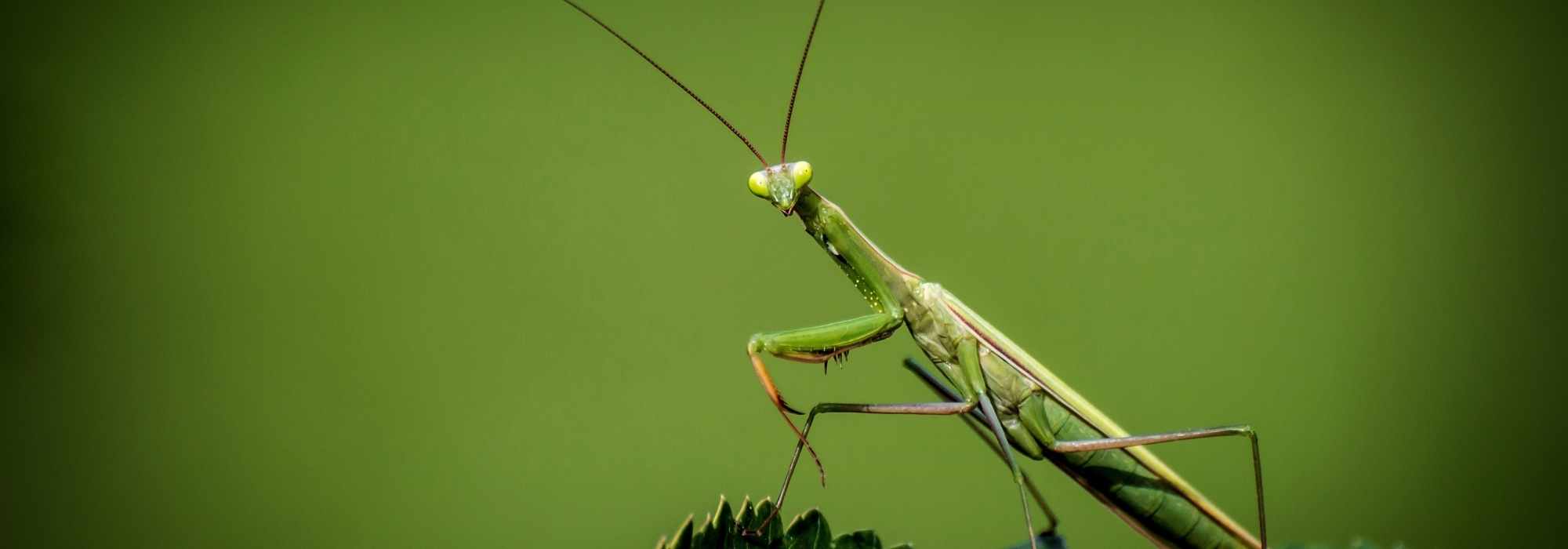
Praying mantis - Mantis religiosa: what is this insect?
A fascinating insect
Contents
The praying mantis or Mantis religiosa has many nicknames, such as God’s horse or Devil’s horse. It is an insect as beautiful as it is astonishing, playing a significant role in nature and in our gardens. The praying mantis is not dangerous to humans, but is a formidable predator of insects, sometimes pests, thanks to its grasping legs. A true friend to gardeners, the praying mantis requires dense natural areas (mixed hedges, grassy strips, meadows…) that are left somewhat wild to live and hunt effectively. Let’s discover more about this friendly and fascinating insect in our advice sheet.
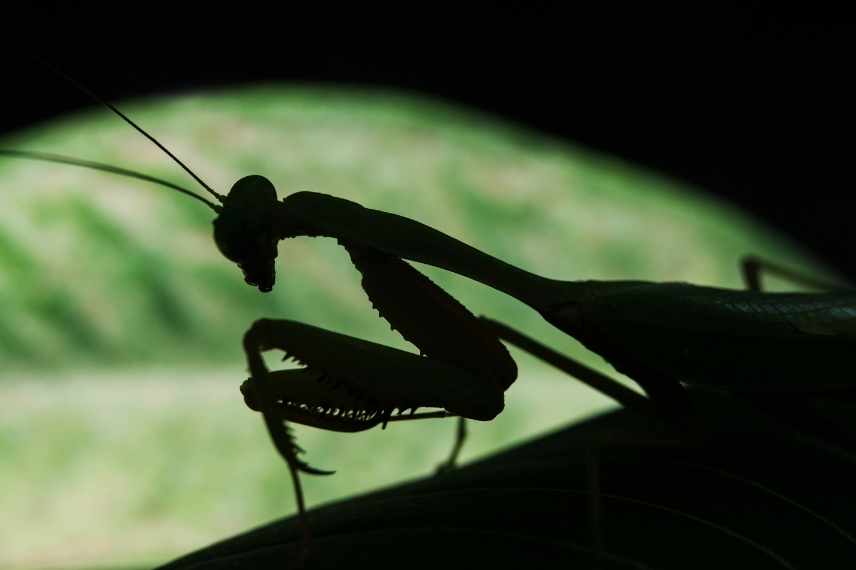 Recognisable among all… the praying mantis
Recognisable among all… the praying mantis
How to recognise a Praying Mantis?
The Praying Mantis or Mantis religiosa, also known as the Devil’s Horse or God’s Horse, is a diurnal insect that belongs to the family Mantidae and the order Mantodea. Formerly described and named by Linnaeus in 1758 as Gryllus religiosus, the Praying Mantis is the only species in the genus Mantis (according to the latest classification).
Mantis religiosa can be green, brown, or beige (or very rarely yellow), which allows it to blend into the vegetation and remain well-camouflaged while on the lookout. According to recent research, adults are capable of changing colour in an incomplete manner from brown to green in autumn to adapt to their environment. The insect measures between 6 and 8 cm, with males being 2 cm smaller and much slimmer than females. Both sexes are theoretically capable of flying in short bursts. However, the female becomes heavier as she approaches laying eggs, which forces her to move only using her hind legs at that time. The male also has longer antennae and 8 sterna (chitin plates of the abdomen) compared to 6 for the female.
The forelegs (anterior legs) are covered in spines and can fold and unfold at incredible speed: they are known as “raptorial legs”. The forelegs of mantises allow them to climb vegetation, but also (and especially!) to catch prey: insects, sometimes larger than themselves, and occasionally spiders. Small spots or ocelli on the inner surface of the raptorial legs resemble eyes, which is why the mantis presents them in front of itself in the presence of a predator. In a similar vein, mantises can fan out their wings (adorned with ocelli, patterns resembling eyes) to appear more impressive.
An excellent predator (as we will see later), the Mantis has remarkable vision thanks to its two large compound eyes, which allow it to see in relief up to 20 m (it is the only insect capable of seeing in 3D), its 3 simple eyes or ocelli, and its ability to rotate its triangular head 180° without moving its body. Furthermore, its antennae feature sensilla, sensory organs that provide even better analysis of its environment, particularly in detecting air vibrations caused by passing insects.
Note: mantises are not venomous and are not dangerous to humans. However, if handled roughly, these small insects can bite (note: we have not personally verified the pain of this bite, so feel free to share your experience in the comments).
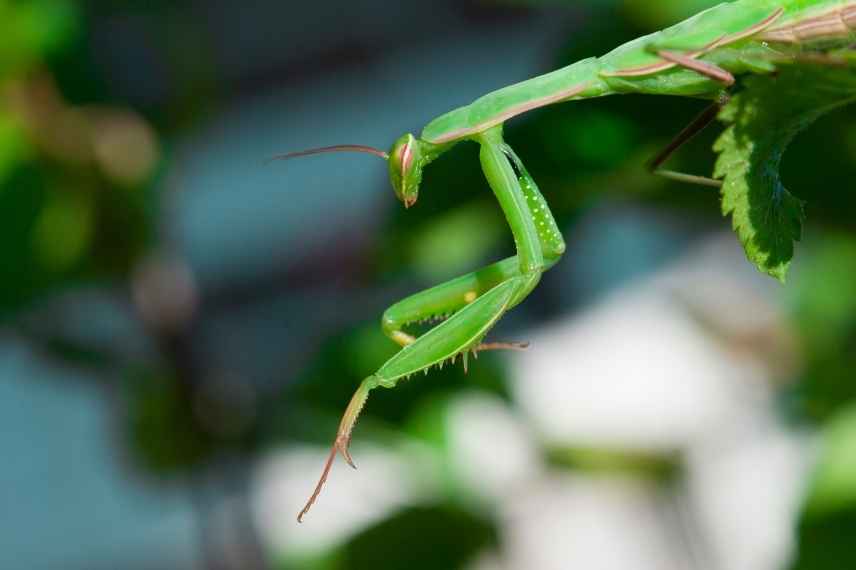
A remarkable pair of legs!
Le cycle de vie d'une mante religieuse se compose de plusieurs étapes distinctes : 1. **Oeufs** : La femelle pond des œufs dans une structure appelée oothèque, qui est une sorte de capsule protectrice. Cette oothèque peut contenir de 10 à 400 œufs, selon l'espèce. 2. **Nymphe** : Après quelques semaines, les œufs éclosent et les jeunes mantises, appelées nymphe, émergent. Elles ressemblent déjà à des adultes, mais sont beaucoup plus petites et n'ont pas encore développé leurs ailes. 3. **Mue** : Les nymphes passent par plusieurs stades de mue, généralement entre 5 et 10, au cours desquels elles grandissent et se développent. À chaque mue, elles perdent leur exosquelette et en forment un nouveau. 4. **Adulte** : Après avoir atteint leur dernier stade de mue, les mantises deviennent adultes. À ce stade, elles sont capables de se reproduire. Les mâles sont généralement plus petits que les femelles. 5. **Reproduction** : La reproduction a lieu au printemps ou en été. Après l'accouplement, il n'est pas rare que la femelle consomme le mâle, un comportement connu sous le nom de cannibalisme sexuel. 6. **Fin de vie** : Les mantises adultes vivent généralement de 6 mois à un an, selon les conditions environnementales et la disponibilité de nourriture. Ce cycle de vie permet à la mante religieuse de s'adapter et de survivre dans divers habitats.
Please note: the life cycle dates are only valid for praying mantises living in Europe. Some differences may be observed in North America or Asia.
- August to October, mating: approaching the female mantis as a small male is no easy task. He sometimes loses his head. Literally. Indeed, he can be devoured before mating and… during it. When this latter scenario occurs, the male, even half-devoured, will continue to fertilise the female. It was long believed that the consumption of her mate provided additional protein for the female. However, it is now known that the female has enough protein to lay her eggs regardless. The female only devours the male if she is hungry during mating. This phenomenon does not occur with every mating in the wild (it is even relatively rare), but it is almost systematic in captivity. A praying mantis lives less than a year, so it is not surprising that the male takes all the risks to ensure the continuation of the species at any cost. Entomologists also believe that “distracting” the female by offering his head (and the rest!) allows for longer, and therefore probably better, fertilisation;
- From September to November, egg-laying: the mantis will produce a kind of sticky foam that, once hardened by oxidation, becomes very solid. With this foam, she will construct a sort of solid structure. This astonishing structure is the ootheca and will serve to protect the mantis eggs. The mantis can produce several oothecae and lay between 200 and 300 eggs. The oothecae are attached to various supports: walls, stones, sturdy stems…
- From May to June, emergence: about a hundred larvae emerge from the ootheca. They will moult for the first time and already resemble tiny mantises: this is a hemimetabolous development (progressive development through several moults, without an immobile stage between larva and adult, the larvae resemble adults without wings). They will thus moult successively 6 times in total to reach adulthood. In the meantime, they are very vulnerable and many of them will be devoured by their usual predators (birds, spiders, other insects like ants, lizards…).
- A praying mantis lives on average between 6 and 9 months. The mantis does not survive the winter, as it dies before it arrives.
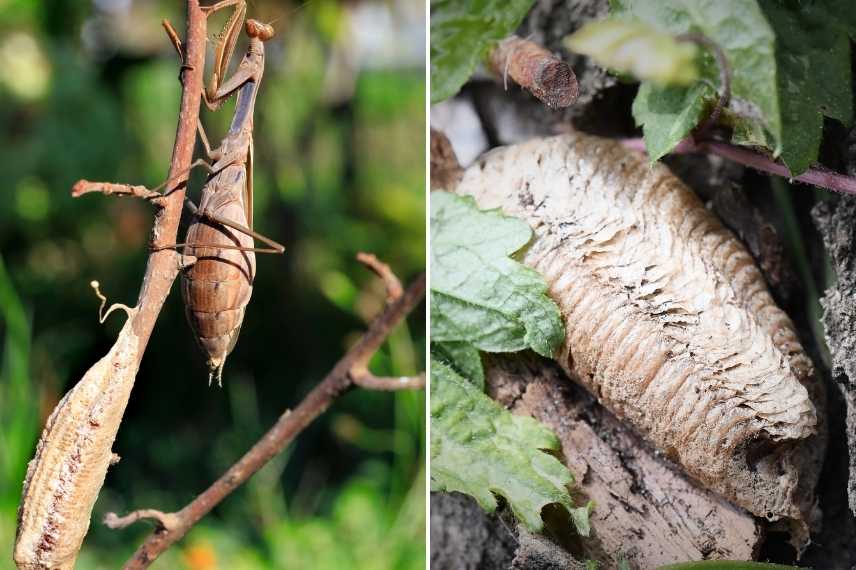
Ootheca of the praying mantis
Where can one encounter Mantis religiosa?
The Praying Mantis is native to the Mediterranean basin. Over time, it has moved further north to Brittany and Normandy, and even across Asia to Japan. It can also be found in the Maghreb and at the Cape of Good Hope, in Australia, as well as on the American continent. The species has been widely introduced in the United States to combat pest insects. Unfortunately, the Praying Mantis quickly became an invasive species there, posing problems for the balance of biodiversity on the continent.
In gardens and in nature, it can be found in tall herbs, bushes, fallow fields, and embankments. In short, in somewhat wild places, quite dense and rich in vegetation so that it can remain alert without being seen. It goes without saying that to welcome it in the garden, one must garden in harmony with nature, plant mixed hedges, and leave a few areas fallow here and there.

The praying mantis finds shelter and a larder in the vegetation
What is the role of this insect in nature and in the garden?
Eat and be eaten! That is its role.
As a predator, the Praying Mantis reduces insect populations, sometimes pests of crops or predators of beneficial insects such as those involved in pollination. As a carnivorous-insectivorous species, it primarily consumes flies, mosquitoes, day and night butterflies (for the latter, the mantis hunts them inside homes), grasshoppers, and crickets… The mantis catches the living insect and, using grinding mouthparts, first attacks the cervical ganglia before consuming the rest of the body, leaving indigestible parts behind: legs and certain wings. Its predatory activity has earned it the nickname “tiger of the grass.” The adult mantis’s predatory activity is too short during the year to significantly reduce pest populations; however, the larva consumes a large number of smaller prey such as aphids, thrips, or gnats.
As prey, the Praying Mantis proves to be a delicacy for birds, spiders, and reptiles such as snakes and lizards.
If you find a praying mantis indoors, gently capture it using a glass and a piece of paper and release it outside onto a bush. Thank you for them!

Praying Mantis eating a grasshopper
- Subscribe!
- Contents
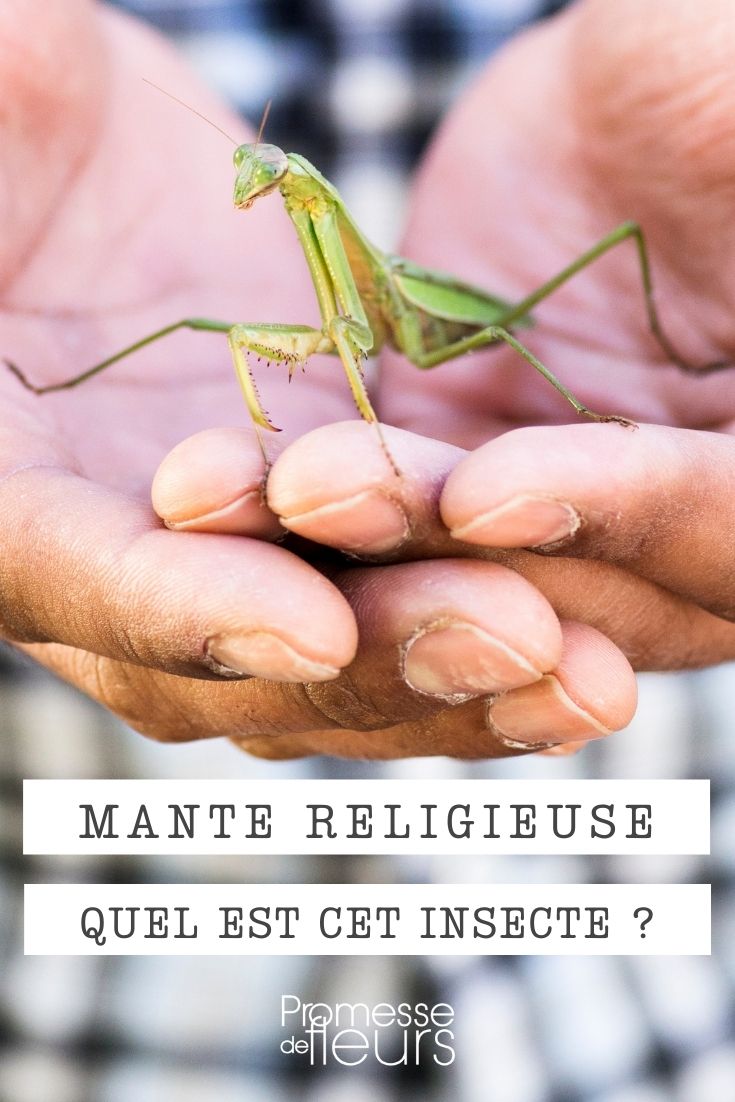






























Comments